Double Standards Faced by Muslim Women in Islamic Societies
VerifiedAdded on 2023/04/23
|7
|2511
|444
AI Summary
This essay discusses the double standards faced by Muslim women in Islamic societies, focusing on gender roles, identity, and the impact of hip-hop culture. It analyzes two articles on Muslim girls in Canadian Islamic schools and the roles of Black Muslim women in the hip-hop industry.
Contribute Materials
Your contribution can guide someone’s learning journey. Share your
documents today.

Running Head: SOCIOLOGY
0
Sociology
3/16/2019
0
Sociology
3/16/2019
Secure Best Marks with AI Grader
Need help grading? Try our AI Grader for instant feedback on your assignments.
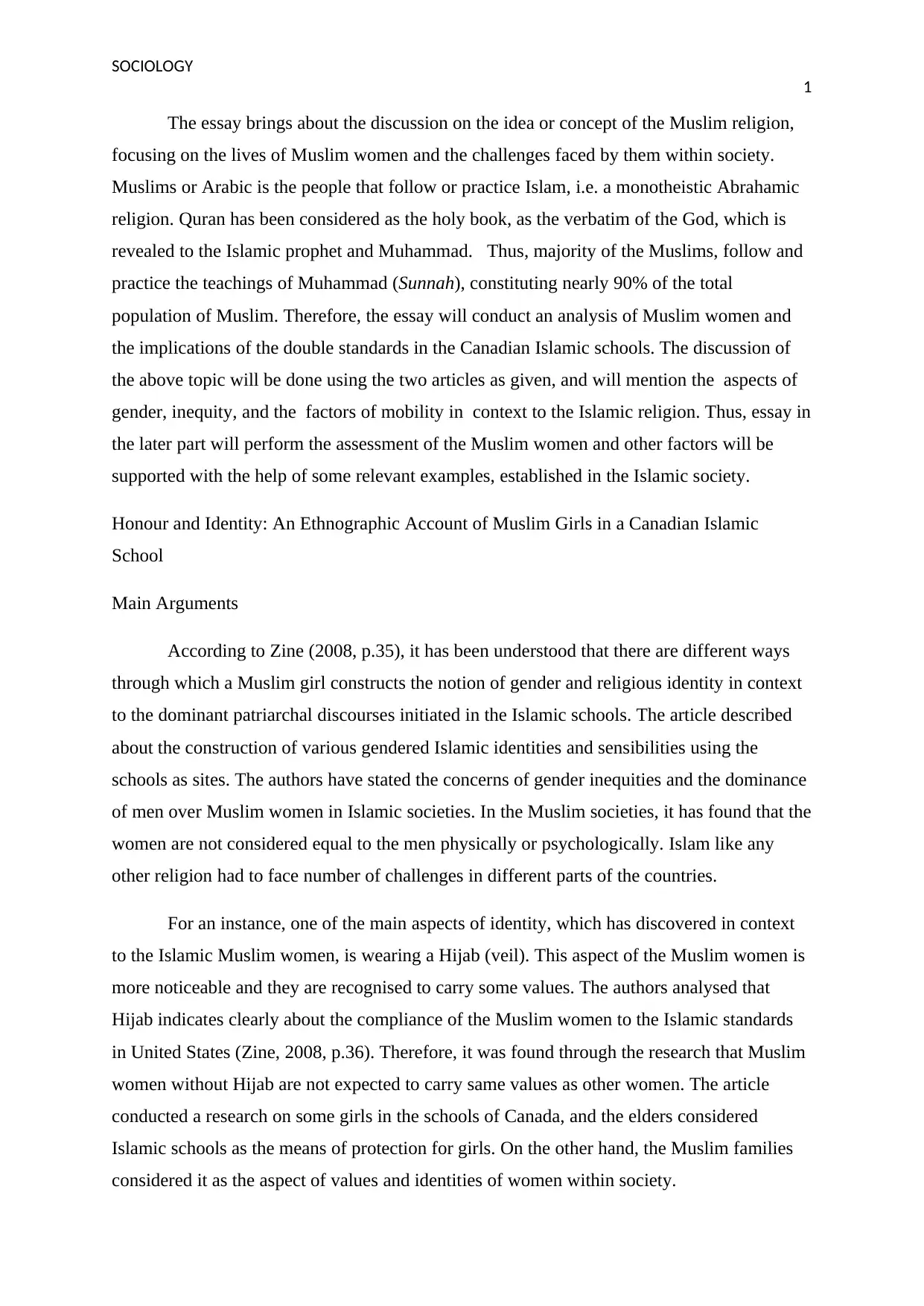
SOCIOLOGY
1
The essay brings about the discussion on the idea or concept of the Muslim religion,
focusing on the lives of Muslim women and the challenges faced by them within society.
Muslims or Arabic is the people that follow or practice Islam, i.e. a monotheistic Abrahamic
religion. Quran has been considered as the holy book, as the verbatim of the God, which is
revealed to the Islamic prophet and Muhammad. Thus, majority of the Muslims, follow and
practice the teachings of Muhammad (Sunnah), constituting nearly 90% of the total
population of Muslim. Therefore, the essay will conduct an analysis of Muslim women and
the implications of the double standards in the Canadian Islamic schools. The discussion of
the above topic will be done using the two articles as given, and will mention the aspects of
gender, inequity, and the factors of mobility in context to the Islamic religion. Thus, essay in
the later part will perform the assessment of the Muslim women and other factors will be
supported with the help of some relevant examples, established in the Islamic society.
Honour and Identity: An Ethnographic Account of Muslim Girls in a Canadian Islamic
School
Main Arguments
According to Zine (2008, p.35), it has been understood that there are different ways
through which a Muslim girl constructs the notion of gender and religious identity in context
to the dominant patriarchal discourses initiated in the Islamic schools. The article described
about the construction of various gendered Islamic identities and sensibilities using the
schools as sites. The authors have stated the concerns of gender inequities and the dominance
of men over Muslim women in Islamic societies. In the Muslim societies, it has found that the
women are not considered equal to the men physically or psychologically. Islam like any
other religion had to face number of challenges in different parts of the countries.
For an instance, one of the main aspects of identity, which has discovered in context
to the Islamic Muslim women, is wearing a Hijab (veil). This aspect of the Muslim women is
more noticeable and they are recognised to carry some values. The authors analysed that
Hijab indicates clearly about the compliance of the Muslim women to the Islamic standards
in United States (Zine, 2008, p.36). Therefore, it was found through the research that Muslim
women without Hijab are not expected to carry same values as other women. The article
conducted a research on some girls in the schools of Canada, and the elders considered
Islamic schools as the means of protection for girls. On the other hand, the Muslim families
considered it as the aspect of values and identities of women within society.
1
The essay brings about the discussion on the idea or concept of the Muslim religion,
focusing on the lives of Muslim women and the challenges faced by them within society.
Muslims or Arabic is the people that follow or practice Islam, i.e. a monotheistic Abrahamic
religion. Quran has been considered as the holy book, as the verbatim of the God, which is
revealed to the Islamic prophet and Muhammad. Thus, majority of the Muslims, follow and
practice the teachings of Muhammad (Sunnah), constituting nearly 90% of the total
population of Muslim. Therefore, the essay will conduct an analysis of Muslim women and
the implications of the double standards in the Canadian Islamic schools. The discussion of
the above topic will be done using the two articles as given, and will mention the aspects of
gender, inequity, and the factors of mobility in context to the Islamic religion. Thus, essay in
the later part will perform the assessment of the Muslim women and other factors will be
supported with the help of some relevant examples, established in the Islamic society.
Honour and Identity: An Ethnographic Account of Muslim Girls in a Canadian Islamic
School
Main Arguments
According to Zine (2008, p.35), it has been understood that there are different ways
through which a Muslim girl constructs the notion of gender and religious identity in context
to the dominant patriarchal discourses initiated in the Islamic schools. The article described
about the construction of various gendered Islamic identities and sensibilities using the
schools as sites. The authors have stated the concerns of gender inequities and the dominance
of men over Muslim women in Islamic societies. In the Muslim societies, it has found that the
women are not considered equal to the men physically or psychologically. Islam like any
other religion had to face number of challenges in different parts of the countries.
For an instance, one of the main aspects of identity, which has discovered in context
to the Islamic Muslim women, is wearing a Hijab (veil). This aspect of the Muslim women is
more noticeable and they are recognised to carry some values. The authors analysed that
Hijab indicates clearly about the compliance of the Muslim women to the Islamic standards
in United States (Zine, 2008, p.36). Therefore, it was found through the research that Muslim
women without Hijab are not expected to carry same values as other women. The article
conducted a research on some girls in the schools of Canada, and the elders considered
Islamic schools as the means of protection for girls. On the other hand, the Muslim families
considered it as the aspect of values and identities of women within society.
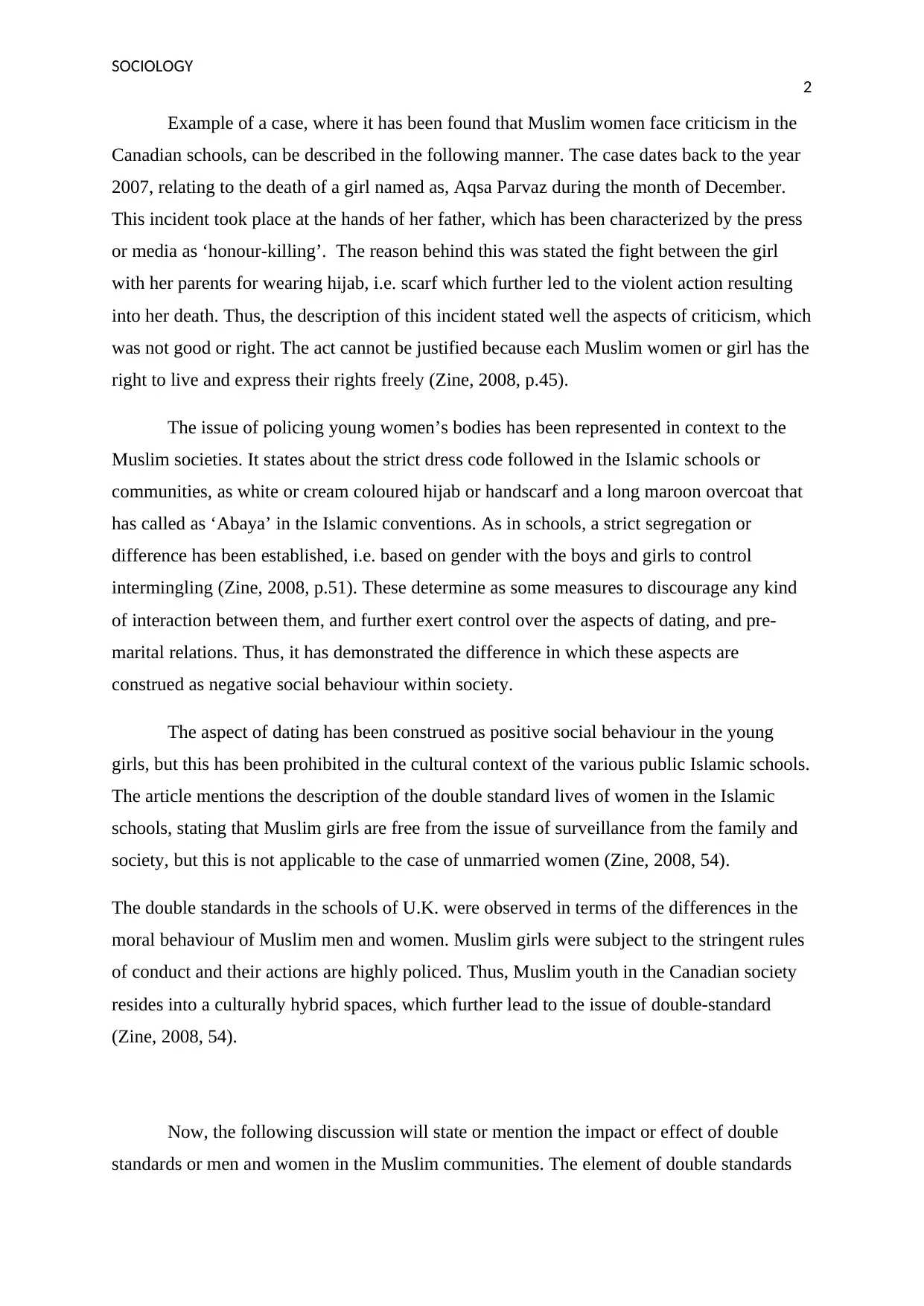
SOCIOLOGY
2
Example of a case, where it has been found that Muslim women face criticism in the
Canadian schools, can be described in the following manner. The case dates back to the year
2007, relating to the death of a girl named as, Aqsa Parvaz during the month of December.
This incident took place at the hands of her father, which has been characterized by the press
or media as ‘honour-killing’. The reason behind this was stated the fight between the girl
with her parents for wearing hijab, i.e. scarf which further led to the violent action resulting
into her death. Thus, the description of this incident stated well the aspects of criticism, which
was not good or right. The act cannot be justified because each Muslim women or girl has the
right to live and express their rights freely (Zine, 2008, p.45).
The issue of policing young women’s bodies has been represented in context to the
Muslim societies. It states about the strict dress code followed in the Islamic schools or
communities, as white or cream coloured hijab or handscarf and a long maroon overcoat that
has called as ‘Abaya’ in the Islamic conventions. As in schools, a strict segregation or
difference has been established, i.e. based on gender with the boys and girls to control
intermingling (Zine, 2008, p.51). These determine as some measures to discourage any kind
of interaction between them, and further exert control over the aspects of dating, and pre-
marital relations. Thus, it has demonstrated the difference in which these aspects are
construed as negative social behaviour within society.
The aspect of dating has been construed as positive social behaviour in the young
girls, but this has been prohibited in the cultural context of the various public Islamic schools.
The article mentions the description of the double standard lives of women in the Islamic
schools, stating that Muslim girls are free from the issue of surveillance from the family and
society, but this is not applicable to the case of unmarried women (Zine, 2008, 54).
The double standards in the schools of U.K. were observed in terms of the differences in the
moral behaviour of Muslim men and women. Muslim girls were subject to the stringent rules
of conduct and their actions are highly policed. Thus, Muslim youth in the Canadian society
resides into a culturally hybrid spaces, which further lead to the issue of double-standard
(Zine, 2008, 54).
Now, the following discussion will state or mention the impact or effect of double
standards or men and women in the Muslim communities. The element of double standards
2
Example of a case, where it has been found that Muslim women face criticism in the
Canadian schools, can be described in the following manner. The case dates back to the year
2007, relating to the death of a girl named as, Aqsa Parvaz during the month of December.
This incident took place at the hands of her father, which has been characterized by the press
or media as ‘honour-killing’. The reason behind this was stated the fight between the girl
with her parents for wearing hijab, i.e. scarf which further led to the violent action resulting
into her death. Thus, the description of this incident stated well the aspects of criticism, which
was not good or right. The act cannot be justified because each Muslim women or girl has the
right to live and express their rights freely (Zine, 2008, p.45).
The issue of policing young women’s bodies has been represented in context to the
Muslim societies. It states about the strict dress code followed in the Islamic schools or
communities, as white or cream coloured hijab or handscarf and a long maroon overcoat that
has called as ‘Abaya’ in the Islamic conventions. As in schools, a strict segregation or
difference has been established, i.e. based on gender with the boys and girls to control
intermingling (Zine, 2008, p.51). These determine as some measures to discourage any kind
of interaction between them, and further exert control over the aspects of dating, and pre-
marital relations. Thus, it has demonstrated the difference in which these aspects are
construed as negative social behaviour within society.
The aspect of dating has been construed as positive social behaviour in the young
girls, but this has been prohibited in the cultural context of the various public Islamic schools.
The article mentions the description of the double standard lives of women in the Islamic
schools, stating that Muslim girls are free from the issue of surveillance from the family and
society, but this is not applicable to the case of unmarried women (Zine, 2008, 54).
The double standards in the schools of U.K. were observed in terms of the differences in the
moral behaviour of Muslim men and women. Muslim girls were subject to the stringent rules
of conduct and their actions are highly policed. Thus, Muslim youth in the Canadian society
resides into a culturally hybrid spaces, which further lead to the issue of double-standard
(Zine, 2008, 54).
Now, the following discussion will state or mention the impact or effect of double
standards or men and women in the Muslim communities. The element of double standards
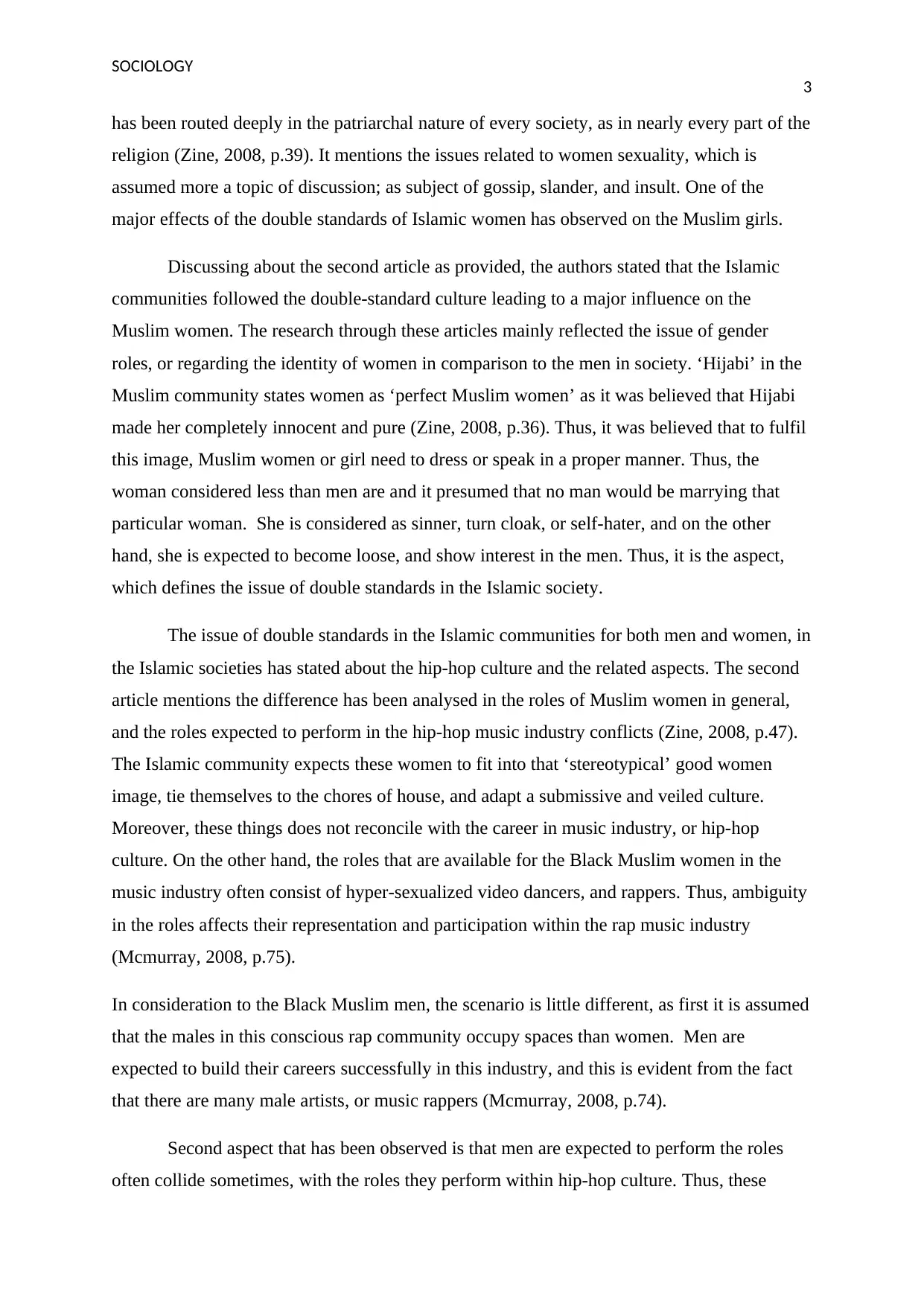
SOCIOLOGY
3
has been routed deeply in the patriarchal nature of every society, as in nearly every part of the
religion (Zine, 2008, p.39). It mentions the issues related to women sexuality, which is
assumed more a topic of discussion; as subject of gossip, slander, and insult. One of the
major effects of the double standards of Islamic women has observed on the Muslim girls.
Discussing about the second article as provided, the authors stated that the Islamic
communities followed the double-standard culture leading to a major influence on the
Muslim women. The research through these articles mainly reflected the issue of gender
roles, or regarding the identity of women in comparison to the men in society. ‘Hijabi’ in the
Muslim community states women as ‘perfect Muslim women’ as it was believed that Hijabi
made her completely innocent and pure (Zine, 2008, p.36). Thus, it was believed that to fulfil
this image, Muslim women or girl need to dress or speak in a proper manner. Thus, the
woman considered less than men are and it presumed that no man would be marrying that
particular woman. She is considered as sinner, turn cloak, or self-hater, and on the other
hand, she is expected to become loose, and show interest in the men. Thus, it is the aspect,
which defines the issue of double standards in the Islamic society.
The issue of double standards in the Islamic communities for both men and women, in
the Islamic societies has stated about the hip-hop culture and the related aspects. The second
article mentions the difference has been analysed in the roles of Muslim women in general,
and the roles expected to perform in the hip-hop music industry conflicts (Zine, 2008, p.47).
The Islamic community expects these women to fit into that ‘stereotypical’ good women
image, tie themselves to the chores of house, and adapt a submissive and veiled culture.
Moreover, these things does not reconcile with the career in music industry, or hip-hop
culture. On the other hand, the roles that are available for the Black Muslim women in the
music industry often consist of hyper-sexualized video dancers, and rappers. Thus, ambiguity
in the roles affects their representation and participation within the rap music industry
(Mcmurray, 2008, p.75).
In consideration to the Black Muslim men, the scenario is little different, as first it is assumed
that the males in this conscious rap community occupy spaces than women. Men are
expected to build their careers successfully in this industry, and this is evident from the fact
that there are many male artists, or music rappers (Mcmurray, 2008, p.74).
Second aspect that has been observed is that men are expected to perform the roles
often collide sometimes, with the roles they perform within hip-hop culture. Thus, these
3
has been routed deeply in the patriarchal nature of every society, as in nearly every part of the
religion (Zine, 2008, p.39). It mentions the issues related to women sexuality, which is
assumed more a topic of discussion; as subject of gossip, slander, and insult. One of the
major effects of the double standards of Islamic women has observed on the Muslim girls.
Discussing about the second article as provided, the authors stated that the Islamic
communities followed the double-standard culture leading to a major influence on the
Muslim women. The research through these articles mainly reflected the issue of gender
roles, or regarding the identity of women in comparison to the men in society. ‘Hijabi’ in the
Muslim community states women as ‘perfect Muslim women’ as it was believed that Hijabi
made her completely innocent and pure (Zine, 2008, p.36). Thus, it was believed that to fulfil
this image, Muslim women or girl need to dress or speak in a proper manner. Thus, the
woman considered less than men are and it presumed that no man would be marrying that
particular woman. She is considered as sinner, turn cloak, or self-hater, and on the other
hand, she is expected to become loose, and show interest in the men. Thus, it is the aspect,
which defines the issue of double standards in the Islamic society.
The issue of double standards in the Islamic communities for both men and women, in
the Islamic societies has stated about the hip-hop culture and the related aspects. The second
article mentions the difference has been analysed in the roles of Muslim women in general,
and the roles expected to perform in the hip-hop music industry conflicts (Zine, 2008, p.47).
The Islamic community expects these women to fit into that ‘stereotypical’ good women
image, tie themselves to the chores of house, and adapt a submissive and veiled culture.
Moreover, these things does not reconcile with the career in music industry, or hip-hop
culture. On the other hand, the roles that are available for the Black Muslim women in the
music industry often consist of hyper-sexualized video dancers, and rappers. Thus, ambiguity
in the roles affects their representation and participation within the rap music industry
(Mcmurray, 2008, p.75).
In consideration to the Black Muslim men, the scenario is little different, as first it is assumed
that the males in this conscious rap community occupy spaces than women. Men are
expected to build their careers successfully in this industry, and this is evident from the fact
that there are many male artists, or music rappers (Mcmurray, 2008, p.74).
Second aspect that has been observed is that men are expected to perform the roles
often collide sometimes, with the roles they perform within hip-hop culture. Thus, these
Secure Best Marks with AI Grader
Need help grading? Try our AI Grader for instant feedback on your assignments.
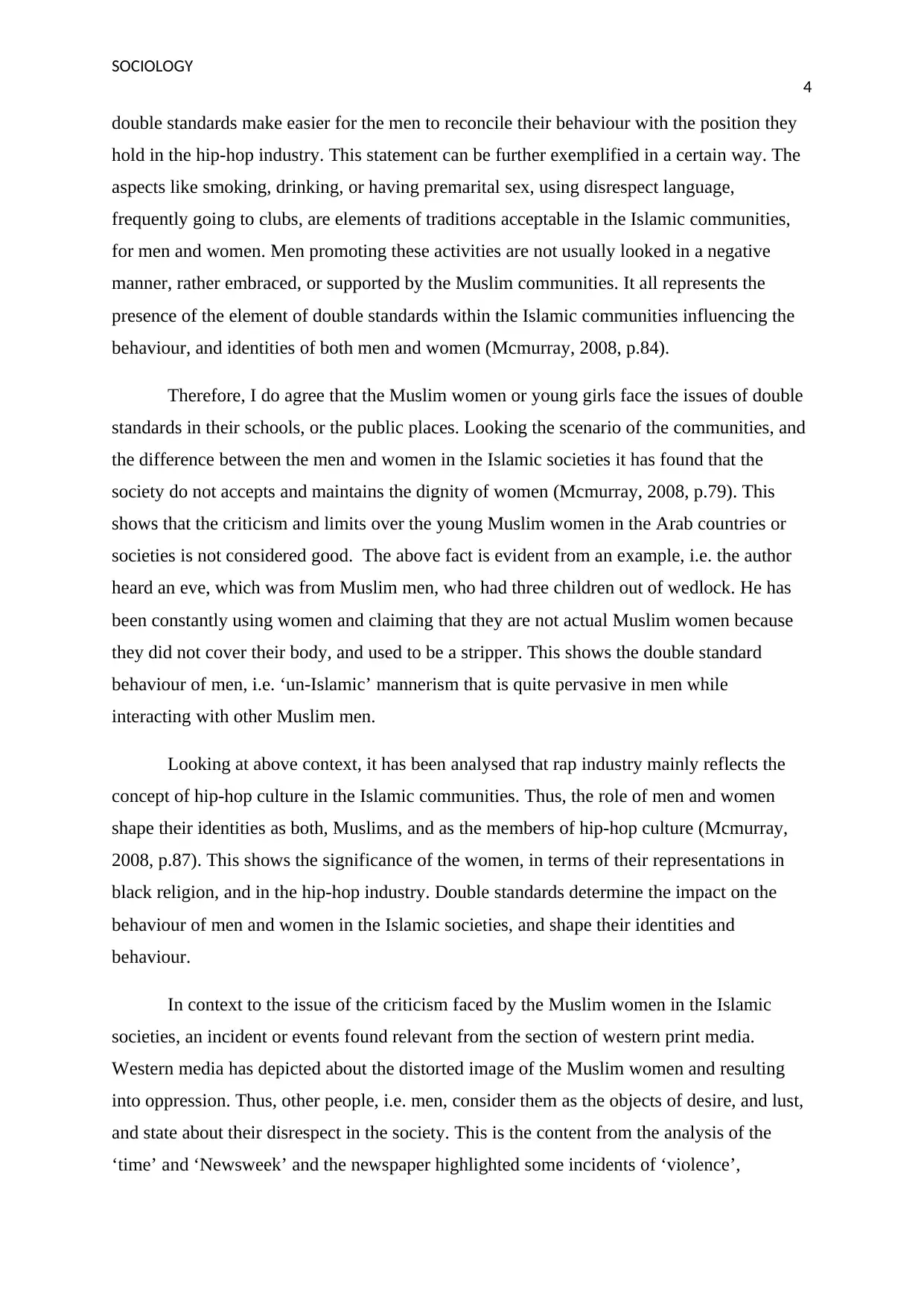
SOCIOLOGY
4
double standards make easier for the men to reconcile their behaviour with the position they
hold in the hip-hop industry. This statement can be further exemplified in a certain way. The
aspects like smoking, drinking, or having premarital sex, using disrespect language,
frequently going to clubs, are elements of traditions acceptable in the Islamic communities,
for men and women. Men promoting these activities are not usually looked in a negative
manner, rather embraced, or supported by the Muslim communities. It all represents the
presence of the element of double standards within the Islamic communities influencing the
behaviour, and identities of both men and women (Mcmurray, 2008, p.84).
Therefore, I do agree that the Muslim women or young girls face the issues of double
standards in their schools, or the public places. Looking the scenario of the communities, and
the difference between the men and women in the Islamic societies it has found that the
society do not accepts and maintains the dignity of women (Mcmurray, 2008, p.79). This
shows that the criticism and limits over the young Muslim women in the Arab countries or
societies is not considered good. The above fact is evident from an example, i.e. the author
heard an eve, which was from Muslim men, who had three children out of wedlock. He has
been constantly using women and claiming that they are not actual Muslim women because
they did not cover their body, and used to be a stripper. This shows the double standard
behaviour of men, i.e. ‘un-Islamic’ mannerism that is quite pervasive in men while
interacting with other Muslim men.
Looking at above context, it has been analysed that rap industry mainly reflects the
concept of hip-hop culture in the Islamic communities. Thus, the role of men and women
shape their identities as both, Muslims, and as the members of hip-hop culture (Mcmurray,
2008, p.87). This shows the significance of the women, in terms of their representations in
black religion, and in the hip-hop industry. Double standards determine the impact on the
behaviour of men and women in the Islamic societies, and shape their identities and
behaviour.
In context to the issue of the criticism faced by the Muslim women in the Islamic
societies, an incident or events found relevant from the section of western print media.
Western media has depicted about the distorted image of the Muslim women and resulting
into oppression. Thus, other people, i.e. men, consider them as the objects of desire, and lust,
and state about their disrespect in the society. This is the content from the analysis of the
‘time’ and ‘Newsweek’ and the newspaper highlighted some incidents of ‘violence’,
4
double standards make easier for the men to reconcile their behaviour with the position they
hold in the hip-hop industry. This statement can be further exemplified in a certain way. The
aspects like smoking, drinking, or having premarital sex, using disrespect language,
frequently going to clubs, are elements of traditions acceptable in the Islamic communities,
for men and women. Men promoting these activities are not usually looked in a negative
manner, rather embraced, or supported by the Muslim communities. It all represents the
presence of the element of double standards within the Islamic communities influencing the
behaviour, and identities of both men and women (Mcmurray, 2008, p.84).
Therefore, I do agree that the Muslim women or young girls face the issues of double
standards in their schools, or the public places. Looking the scenario of the communities, and
the difference between the men and women in the Islamic societies it has found that the
society do not accepts and maintains the dignity of women (Mcmurray, 2008, p.79). This
shows that the criticism and limits over the young Muslim women in the Arab countries or
societies is not considered good. The above fact is evident from an example, i.e. the author
heard an eve, which was from Muslim men, who had three children out of wedlock. He has
been constantly using women and claiming that they are not actual Muslim women because
they did not cover their body, and used to be a stripper. This shows the double standard
behaviour of men, i.e. ‘un-Islamic’ mannerism that is quite pervasive in men while
interacting with other Muslim men.
Looking at above context, it has been analysed that rap industry mainly reflects the
concept of hip-hop culture in the Islamic communities. Thus, the role of men and women
shape their identities as both, Muslims, and as the members of hip-hop culture (Mcmurray,
2008, p.87). This shows the significance of the women, in terms of their representations in
black religion, and in the hip-hop industry. Double standards determine the impact on the
behaviour of men and women in the Islamic societies, and shape their identities and
behaviour.
In context to the issue of the criticism faced by the Muslim women in the Islamic
societies, an incident or events found relevant from the section of western print media.
Western media has depicted about the distorted image of the Muslim women and resulting
into oppression. Thus, other people, i.e. men, consider them as the objects of desire, and lust,
and state about their disrespect in the society. This is the content from the analysis of the
‘time’ and ‘Newsweek’ and the newspaper highlighted some incidents of ‘violence’,
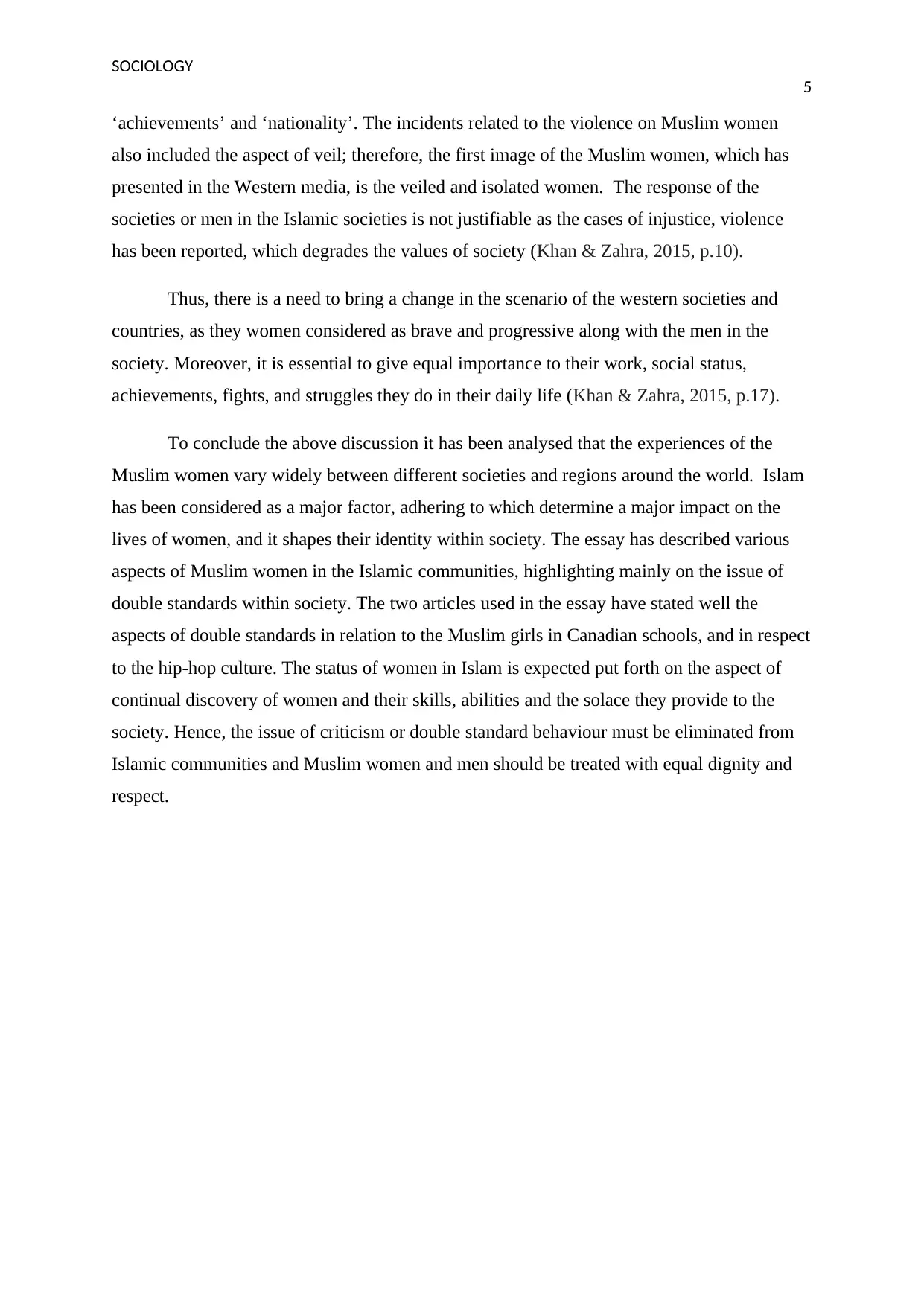
SOCIOLOGY
5
‘achievements’ and ‘nationality’. The incidents related to the violence on Muslim women
also included the aspect of veil; therefore, the first image of the Muslim women, which has
presented in the Western media, is the veiled and isolated women. The response of the
societies or men in the Islamic societies is not justifiable as the cases of injustice, violence
has been reported, which degrades the values of society (Khan & Zahra, 2015, p.10).
Thus, there is a need to bring a change in the scenario of the western societies and
countries, as they women considered as brave and progressive along with the men in the
society. Moreover, it is essential to give equal importance to their work, social status,
achievements, fights, and struggles they do in their daily life (Khan & Zahra, 2015, p.17).
To conclude the above discussion it has been analysed that the experiences of the
Muslim women vary widely between different societies and regions around the world. Islam
has been considered as a major factor, adhering to which determine a major impact on the
lives of women, and it shapes their identity within society. The essay has described various
aspects of Muslim women in the Islamic communities, highlighting mainly on the issue of
double standards within society. The two articles used in the essay have stated well the
aspects of double standards in relation to the Muslim girls in Canadian schools, and in respect
to the hip-hop culture. The status of women in Islam is expected put forth on the aspect of
continual discovery of women and their skills, abilities and the solace they provide to the
society. Hence, the issue of criticism or double standard behaviour must be eliminated from
Islamic communities and Muslim women and men should be treated with equal dignity and
respect.
5
‘achievements’ and ‘nationality’. The incidents related to the violence on Muslim women
also included the aspect of veil; therefore, the first image of the Muslim women, which has
presented in the Western media, is the veiled and isolated women. The response of the
societies or men in the Islamic societies is not justifiable as the cases of injustice, violence
has been reported, which degrades the values of society (Khan & Zahra, 2015, p.10).
Thus, there is a need to bring a change in the scenario of the western societies and
countries, as they women considered as brave and progressive along with the men in the
society. Moreover, it is essential to give equal importance to their work, social status,
achievements, fights, and struggles they do in their daily life (Khan & Zahra, 2015, p.17).
To conclude the above discussion it has been analysed that the experiences of the
Muslim women vary widely between different societies and regions around the world. Islam
has been considered as a major factor, adhering to which determine a major impact on the
lives of women, and it shapes their identity within society. The essay has described various
aspects of Muslim women in the Islamic communities, highlighting mainly on the issue of
double standards within society. The two articles used in the essay have stated well the
aspects of double standards in relation to the Muslim girls in Canadian schools, and in respect
to the hip-hop culture. The status of women in Islam is expected put forth on the aspect of
continual discovery of women and their skills, abilities and the solace they provide to the
society. Hence, the issue of criticism or double standard behaviour must be eliminated from
Islamic communities and Muslim women and men should be treated with equal dignity and
respect.
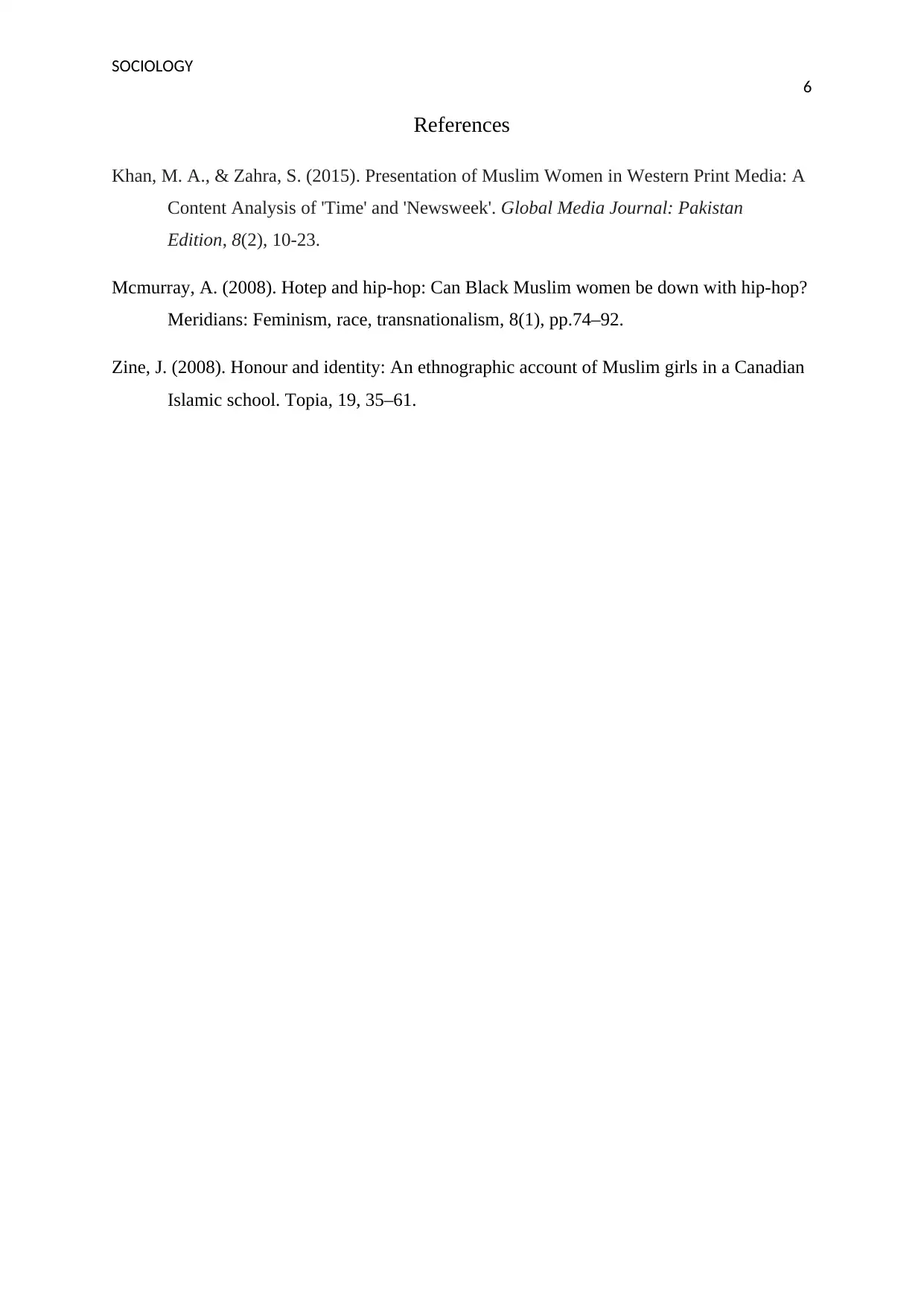
SOCIOLOGY
6
References
Khan, M. A., & Zahra, S. (2015). Presentation of Muslim Women in Western Print Media: A
Content Analysis of 'Time' and 'Newsweek'. Global Media Journal: Pakistan
Edition, 8(2), 10-23.
Mcmurray, A. (2008). Hotep and hip-hop: Can Black Muslim women be down with hip-hop?
Meridians: Feminism, race, transnationalism, 8(1), pp.74–92.
Zine, J. (2008). Honour and identity: An ethnographic account of Muslim girls in a Canadian
Islamic school. Topia, 19, 35–61.
6
References
Khan, M. A., & Zahra, S. (2015). Presentation of Muslim Women in Western Print Media: A
Content Analysis of 'Time' and 'Newsweek'. Global Media Journal: Pakistan
Edition, 8(2), 10-23.
Mcmurray, A. (2008). Hotep and hip-hop: Can Black Muslim women be down with hip-hop?
Meridians: Feminism, race, transnationalism, 8(1), pp.74–92.
Zine, J. (2008). Honour and identity: An ethnographic account of Muslim girls in a Canadian
Islamic school. Topia, 19, 35–61.
1 out of 7
Related Documents
Your All-in-One AI-Powered Toolkit for Academic Success.
+13062052269
info@desklib.com
Available 24*7 on WhatsApp / Email
![[object Object]](/_next/static/media/star-bottom.7253800d.svg)
Unlock your academic potential
© 2024 | Zucol Services PVT LTD | All rights reserved.





